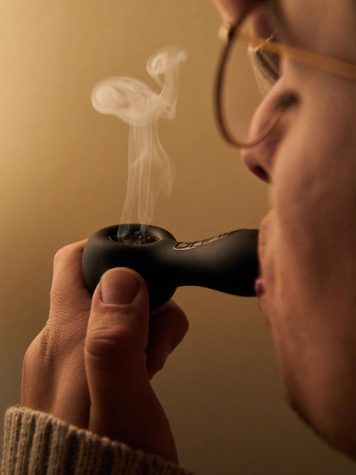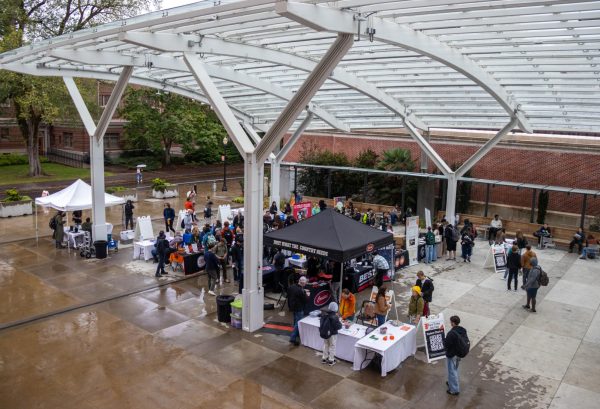- Beavers Digest
- Beavers Digest / Culture
- Beavers Digest / Culture / Community
- Beavers Digest / Culture / Expression
- Beavers Digest / Experience
- Beavers Digest / Experience / Wellness
Breaking down cannabis ingestion with director of OSU’s substance use and neuroscience lab
Matthew McKenna, OMN Photographer
21 year-old OSU sophmore, Cameron Fletcher, tokes from his weed pipe from the comfort of his own home on Dec 9, 2022. Coming from Southern California, Fletcher is no stranger to smoking, eating, or vaping weed.

Due to its legality in Oregon and many other states, cannabis use is on the rise. If one decides to partake in a cannabis experience, it can be beneficial to understand the different ways of ingesting cannabis and doing so safely.
Cannabis can be smoked by rolling the substance up in paper or tobacco in a few different forms, such as a joint: cannabis flower rolled in paper; a blunt: cannabis flower rolled in tobacco leaves; and a spliff: cannabis flower and tobacco rolled in paper.
Weed can also be smoked using devices like a bowl, bong and water pipe, where just cannabis and water are needed—just cannabis if it’s a bowl—in order to smoke the product. Vaping cannabis is another common way to ingest it. One can inhale the substance through a device, which makes it similar to smoking. The vape pen heats up the cannabis oil and produces aerosols for inhalation.
Another method, dabbing, also heats up the cannabis product, usually in the form of wax where there’s a high percentage of THC concentrates. Once the wax is warm enough, the product can be smoked. Edibles are one method of ingesting weed without smoking it. They are commonly found in foods that allow for THC to be easily baked into the baking process, like in brownies or cookies. They can also be found in drinks, such as teas.
Anita Cservenka is assistant professor and director of the Substance Use and Neurocognition Lab at Oregon State University. She specializes in cannabis use with brain development, neurocognitive effects and use with adolescents and young adults.
Cservenka promotes the importance of understanding a substance before you use it, especially how to use it safely.
“Each method is associated with different risks for experiencing potential adverse events,” Cservenka said. “Furthermore, understanding that certain methods of use are associated with differences in timing for experiencing the subjective effects of cannabis may help reduce the risk for overconsumption. It can also be risky to not understand that certain methods are associated with ingesting high potency cannabis that may increase vulnerability for adverse experiences.”
For example, being aware of the fact that blunts and spliffs contain tobacco can alert the person smoking that they could develop a nicotine addiction through consuming them. Someone may also over-consume edibles because the effects of edibles take longer to kick in so the user may keep consuming until they feel high.
The experience of the high comes from THC, the main psychoactive ingredient in cannabis. THC levels range between each method of use, including how many grams of flower are used and hits taken in a single session.
“Smoking can produce a more immediate high than consuming edibles as the inhaled smoke reaches the brain much faster than oral consumption of THC, which must travel through the digestive tract before reaching the brain,” Cservenka said. “Concentrates, which have very high THC content—often 80% or greater— and can be consumed using vape pens, or dabbing, can produce an even stronger effect, and increase the risk for adverse experiences.”
Knowing the risks of cannabis use can allow one to determine what’s best for them if they choose to partake. Though, the safest way to avoid any detrimental effects, like damaging lungs or experiencing an unrewarding high, is to not consume cannabis at all.

“For individuals who do engage in cannabis use, safer consumption methods could include consuming cannabis less frequently, using lower THC products and abstaining from use of concentrates, avoiding smoking methods—especially those combined with tobacco—and avoiding deep inhalation,” Cservenka said. “These may be different ways to use cannabis more safely, which could help decrease the likelihood of experiencing undesirable or adverse effects.”
The safest ways of ingesting aren’t very common with young adults. Cservenka cited a 2021 study that indicated the most common method for this age group is smoking cannabis either in joints, bowls or cigar papers.
The second most common use was vaping. The third was through a water pipe or bong, and the least common method is consuming edibles. Dabbing is growing in popularity in the U.S., resulting in more attention on this high-risk way of ingesting cannabis. Any highly concentrated THC product, like dabbing, has reported more individuals experiencing adverse effects, like paranoid and emergency room visits.
No cannabis user wants to engage in a substance without a reward. Before smoking, it can be beneficial to understand your limit and proceed cautiously. Everyone’s experiences with cannabis are subjective so it can be helpful for you to figure out what works and doesn’t work for you. If you’re going to engage with cannabis, doing research and making sure you’re prioritizing safety can go a long way to reaching the experience you’re looking for.





